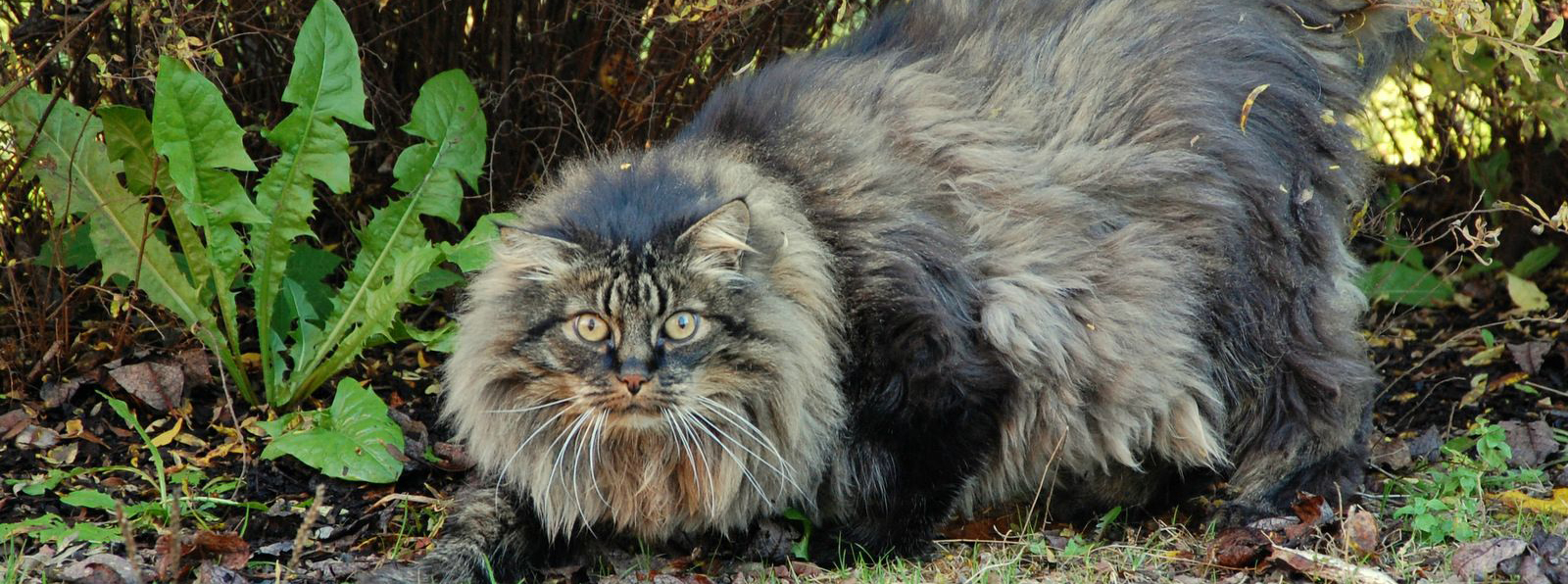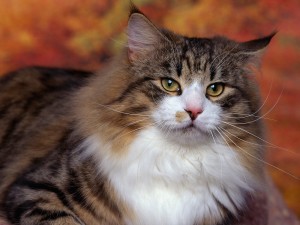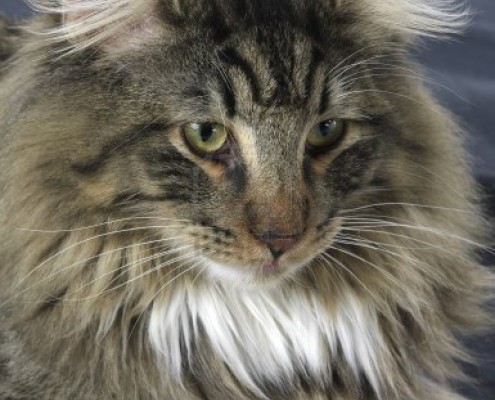Norwegian Forest Cat

Meoww!!
The Norwegian Forest Cat is a breed of domestic cat native to Northern Europe. The Norwegian Forest Cat is adapted to survive Norway’s cold weather.
In 5 Words
- Active
- Playful
- Fun-loving
- Very intelligent
- Sociable
Snapshot
WEIGHT RANGE:
Male: large: >12 lbs.
Female: large: >12 lbs.
EYE COLOR:
Blue, Green, Gold, Odd-eyed
EXPECTATIONS:
Longevity Range: 8-14 yrs.
Social/Attention Needs: High
Tendency to Shed: High
COAT:
Length: Long
Characteristics: Straight
Colors: White, Black, Blue, Red, Cream, Silver, Golden, Red, Cameo, Tortoiseshell, Bluecream, Brown
Pattern: Solid Color, Tortoiseshell, Bicolor, Tricolor/Calico, Tabby, Ticking, Smoke, Shaded
Less Allergenic: No
Overall Grooming Needs: High
CLUB RECOGNITION:
Cat Association Recognition:
CFA, ACFA , FIFe, TICA
Prevalence: Rare

Characteristics
Learn About the Norwegian Forest Cat
The Norwegian Forest Cat is a breed of domestic cat native to Northern Europe. The Norwegian Forest Cat is adapted to survive Norway’s cold weather. As their name implies, the Norwegian Forest Cat originated in Norway. Known as Skogkatter in their native language, Norwegian Forest Cats accompanied the Vikings in their travels throughout Europe. The breed developed on its own in the cold climate of Northern Europe, which led to its profuse, double coat.
Although the Norwegian Forest Cat (NFC) is a relatively new breed in Australia, it is a very old breed in Scandinavia, fashioned by nature, in the forests of Norway. NFC’s are found in Norwegian fairy tales and mythology. Enchanted cats of the forest that could disappear at will.
Although historical records show that cats have been present in Scandinavia for many hundreds of years, there are in fact no wild cats native to Scandinavia. The name may suggest otherwise, but the Norwegian Forest Cat, or ‘Wegie’ is likely a descendent of cats which arrived in Norway as a result of trade routes maintained by Vikings with the East.
With a legend as beautiful as the cat itself, the breeders in Norway began to develop their magical forest cat into a breed that would be accepted for the show bench. The Norwegian Forest Cat was first exhibited at a cat show in Norway before World War II.
The Norwegian Forest Cat is a large heavy-boned, yet elegant semi-longhaired breed, and reflects its natural origins as an outdoor working farm cat used to harsh weather conditions with a distinctive double coat. The woolly undercoat is covered by a smooth, water-repellent overcoat, which consists of long, coarser and glossy guard hairs covering the back, sides and tail.
Norwegian Forest cats chirp similar to racoons in the wild. They have a bird-like sound that they make when talking to each other. They don’t meow unless they are trying to tell you something. Rather quiet compared to many cat breeds.
Norwegian Forest Cats have long tails that are covered profusely in fur. The head is triangular in shape, and the facial expression is sweet. Their paws are large and round, and have heavy tufting between the toes.
Since the cats have very strong claws, they are very good climbers, and can even climb rocks.
The Norwegian Forest Cat’s distinguishing double coat varies in length according to the time of year. The cat goes through a spring ‘molting,’ when the winter coat is shed, and a fall shedding, when the summer coat departs. At these times of year, thorough combing is necessary unless you want seasonal layers of cat hair on everything. The rest of the year the Forest Cat requires minimal grooming since he tends to hang onto his coat, perhaps remembering those harsh winters.
This gentle, laid-back cat is very intelligent and fun loving, energetic and sociable, yet not too demanding, and they make excellent family pets.
The Norwegian has never forgotten his heritage. He is still a hunter at heart. He loves to chase toys as if they are real. He is territorial and patrols several times each day to make certain that all is fine.
Natural athletes, Norwegian Forest Cats love to investigate counters, bookcases, and the loftiest peaks of their cat trees. Wegies are active and playful and retain their fun-loving spirit well into adulthood, but don’t be fooled by the breed’s impressive muscles and all-weather exterior.
This is generally a healthy breed of cat without any breed-related defects, and they can live up to 14-16 years, although they may be prone to kidney or heart defects in later life. The Norwegian Forest Cat needs annual vaccination boosters against the `common feline ailments of flu and enteritis, as well as against Feline Leukaemia if they go outdoors.
Grooming is not difficult on a Forest Cat. Although they will mat if their coat is neglected, they tend not to mat as much as some of the other longhair breeds. As stated earlier they do molt once a year. Although they will mat if their coat is neglected, they tend not to mat as much as some other longhaired breeds. A simple combing of their coat a few times a week will keep it looking lovely and full.






